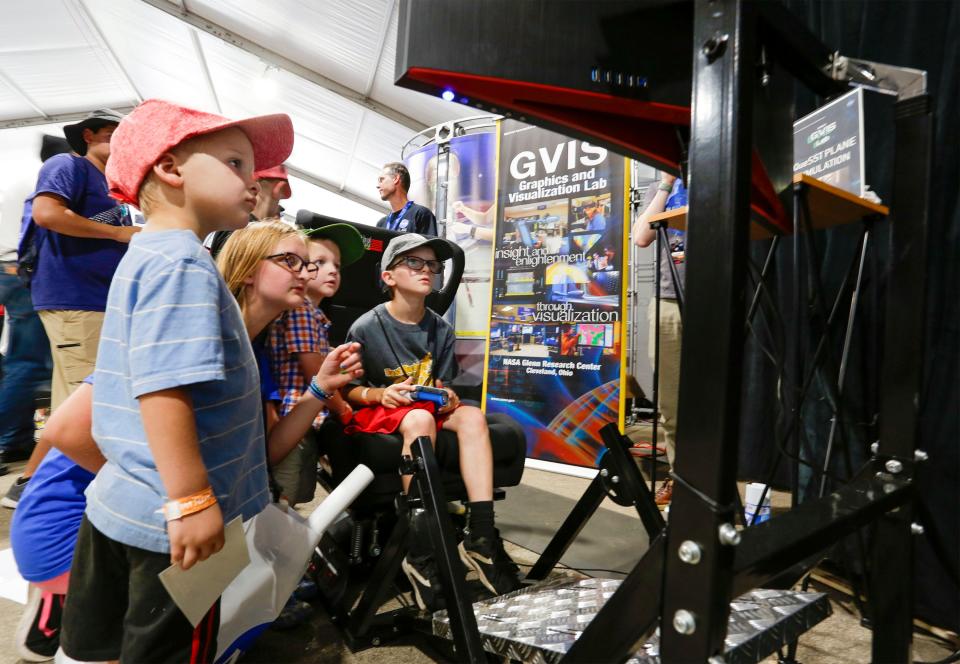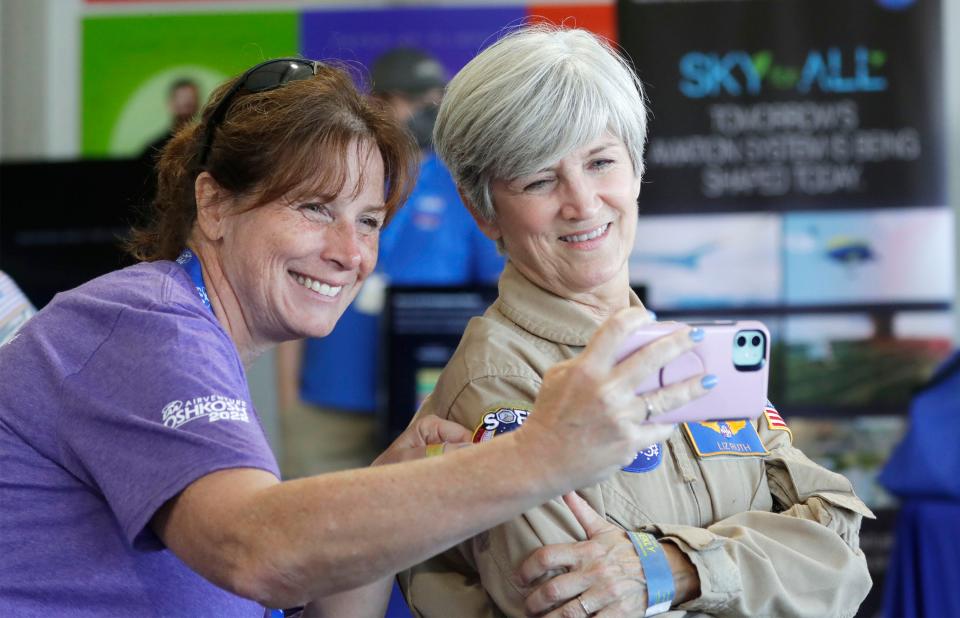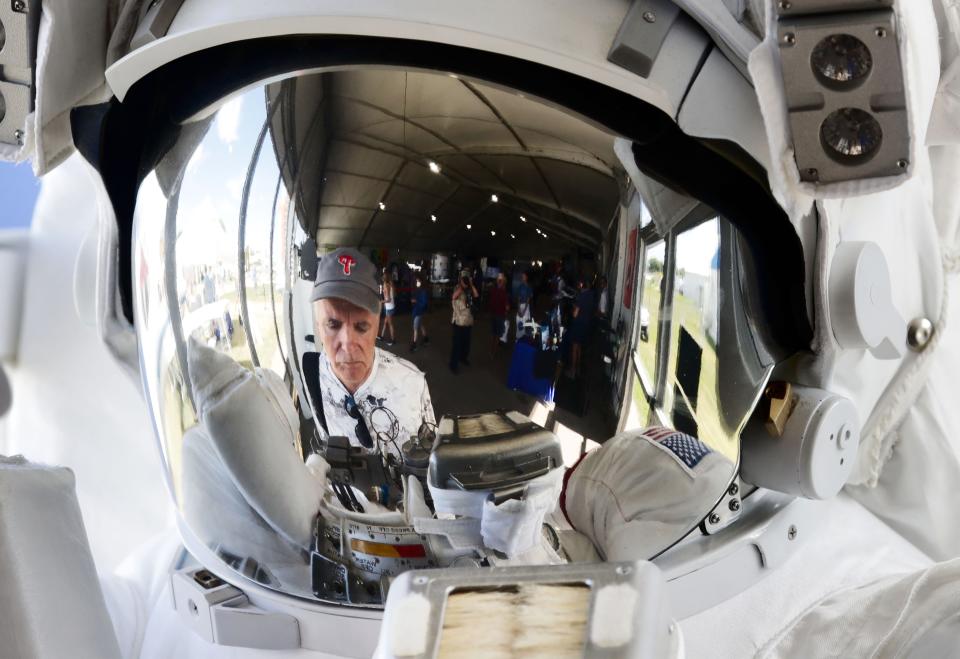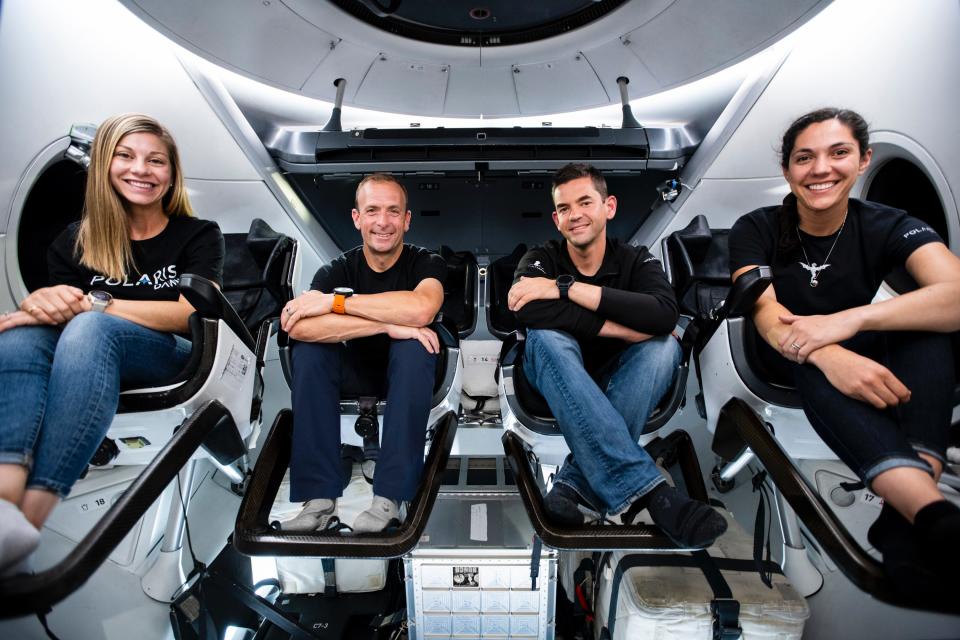The commercial space industry is growing, and Polaris Dawn is sending four civilians to help humanity get ready
OSHKOSH - Scott "Kidd" Poteet figured he would never see space for himself.
Poteet, 48, dreamt of the heavens after seeing "Top Gun" and "The Right Stuff" as a child. He spent 20 years in the U.S. Air Force, but becoming an astronaut wasn't feasible at the time.
Now he's mere months away from rocketing into space as the all-civilian Polaris Dawn's mission pilot — and he's eager to take every chance he can to share his excitement and experience with the world.
The Polaris Dawn team is scheduled to arrive at AirVenture Friday with an aerial show Poteet promised will "turn heads." Friday's space-focused events will culminate with a Theater in the Woods program focusing on Polaris Dawn and the future of space exploration.

Polaris Dawn's four-person crew will spend up to five days in space conducting spacewalks and research, but Poteet said visiting places like Oshkosh also is a key part of the the Polaris Program's purpose.
"We want to excite the crowd, for them to see what’s possible. This is a civilian crew again. The fact we’re able to set these goals, highly achievable goals, should get people inspired to learn more," he said. "Hopefully it will be that ignition, that spark for the next generation."
The Polaris Program is not alone in working to provide that spark. NASA returned to Oshkosh this year with programming about sustainable flight, the X-59 research aircraft's mission to turn the sonic "boom" into a modest "thump", air mobility and its Artemis program to return humans to the Moon.
The public and private sector efforts are supplemented by EAA's own initiatives like AirVenture programs like KidVenture, GirlVenture and WomenVenture that not only provide the spark for students like Rachel Oppmann, but also help to fan the flames as their interest grows.

Oppmann, of Murfreesboro, Tennessee, spent time at AirVenture this year and it helped her decide her interest in studying aerospace engineering wasn't "too much of a leap." Oppmann's passion for flight and engineering were sparked when she earned her Boy Scouts aviation merit badge and took a Young Eagles flight.
The NASA showcase showed her how the aerospace engineering she hopes to study fit into the agency's current efforts to explore space. Additionally, GirlVenture and, this year, WomenVenture, gave her the chance to talk with other women pilots and engineers, reassuring her she will have the support of other women in the industry.
"I know I won't be by myself," Oppmann said. "I feel more confident."
EAA's connections to exploring the cosmos
May marked 10 years since SpaceX's Dragon capsule completed the first commercial resupply mission to the International Space Station. The 1,000-pound cargo delivery came the year after NASA ceased Space Shuttle missions in 2011. It also was a time when the federal government began to standardize private companies' access to launch sites.

The U.S. Bureau of Economic Analysis in January reported the U.S. space industry had grown 11.1% from $174.8 billion in 2012 to $194.3 billion in 2019. Of that, private industry grew by 10.3% from $145.4 billion to $160.5 billion.
As the commercial space industry continues to grow, so will the the number of opportunities for people to work in aerospace fields and to actually go explore space. Research firm BryceTech said the global space industry reached $386 billion in 2021, and is split into sectors like cargo transportation, satellite production and deployment, human transportation to the International Space Station, space tourism and research.
Not every AirVenture is heavy on space, but the Experimental Aircraft Association and its annual AirVenture convention have, over the years, provided a public showcase for new advances in space exploration. EAA President and CEO Jack Pelton said NASA's return to AirVenture this year after a two-year hiatus and the Polaris Dawn team's appearance at Theater in the Woods will give attendees a strong look into the future.
"It's good to see (NASA) back," Pelton said, adding the organization wants to expand its aerospace content.
EAA and AirVenture organizers have provided a venue for private space exploration companies to engage the public public for nearly 20 years. The organization tapped into widespread interest in the $10 million Ansari X Prize competition to be the first private company to send a crewed craft into space twice in two weeks.
The association channeled widespread interest in the $10 million Ansari X Prize competition in 2004 into an appearance at AirVenture 2005 by the prize-winning aircraft — WhiteKnight and SpaceShipOne — which wowed crowds and helped boost attendance 7% over 2004.
It also scored another major win in 2017 when Blue Origin brought its New Shepard reusable rocket to AirVenture's main plaza. The turnout to get a look inside the re-usable spacecraft made an impression on Amazon founder (and, as of July 2021, Blue Origin astronaut) Jeff Bezos, who Tweeted an aerial photo. Blue Origin was part of a standout schedule in 2017 that included the Apollo Program's 50th anniversary and the first AirVenture performance by the U.S. Navy's Blue Angels, pushing attendance up 5% to 590,000 that year.
The focus this year will be on the Polaris Program thanks to EAA member and Polaris Dawn mission commander Jared Isaacman.
The first Polaris mission will fly to a low Earth orbit, but Pelton hopes Isaacman talks on Friday night about Mars.
"It's really interesting," Pelton said. "He's thinking that far out."

Polaris Dawn aims to put civilians in highest low Earth orbit since 1966
The first of three planned Polaris Program missions, Polaris Dawn will send four civilians into the highest low Earth orbit since Gemini 11 orbited more than 850 miles above Earth in 1966. The mission will also attempt to study some of the physiological impacts space has on the human body, conduct a civilian spacewalk with SpaceX's newly-designed spacesuit, and test the use of lasers to improve communication speeds.
"We feel a high sense of responsibility to maximize every opportunity we have to better our understanding for space exploration," Poteet said. "It’s an exciting time in the industry, not only at SpaceX, but throughout the industry."
Polaris Dawn will build on Inspiration4, the world's first all-civilian spaceflight into low Earth orbit. The three-day mission returned to Earth Sept. 18, 2021 after conducting research in orbit and helping raise $154 million for St. Jude Children’s Research Hospital.

Poteet said the crew continues to ramp up training ahead of the mission's launch before the end of the year. The four-person crew plans to work on teambuilding and procedures even as they fly into Oshkosh in a special formation, he said.
"We just want everyone to get excited about the Polaris Dawn mission and space in general," Poteet said. "There’s always an element of inspiration we’re trying to achieve."
Contact Jeff Bollier at (920) 431-8387 or jbollier@gannett.com. Follow him on Twitter at @JeffBollier.
This article originally appeared on Oshkosh Northwestern: Polaris Dawn pilot excited to spark new passion for space in Oshkosh

 Yahoo Autos
Yahoo Autos 